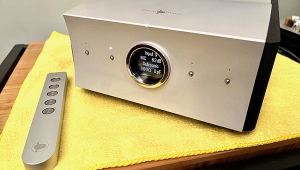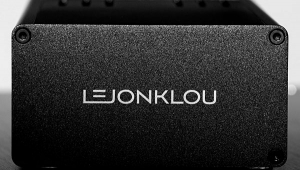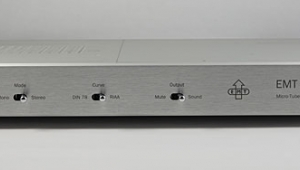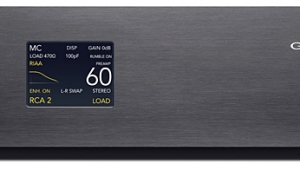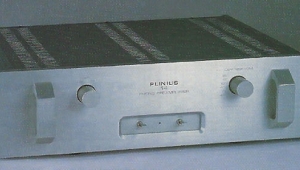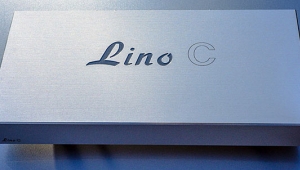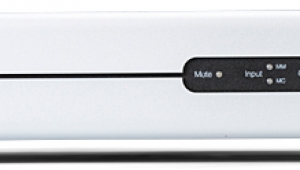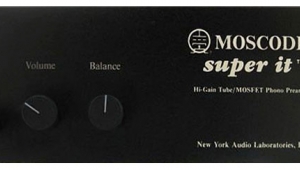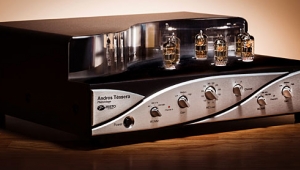| Columns Retired Columns & Blogs |
EAR 324 phono preamplifier
When we last heard from Englishman Tim de Paravicini, whose EAR 890 amp I reviewed in Stereophile's April 2004 issue, the veteran audio designer suggested that he could make a transistor amplifier equal in performance to any of his successful tube designs. Whatever else it may be, the new EAR 324 is my first chance to test that claim: a stereo phono preamplifier without a single tube in sight. It isn't TdP's first all-solid-state product: That would be the line-plus-phono EAR 312 preamplifier, introduced to no small fanfare a little over three years ago. For all intents and purposes, the 324 is a standalone version of the phono section of that $18,000 flagship: The designs are virtually identical—excepting, of course, their casework and power supplies.
Footnote 1: It's also important to choose a precisely correct load impedance so the MC cartridge can damp itself, electrically. I'm reluctant to put my hand in the hornets' nest by suggesting, even approximately, what the right number should be, but I'll speak from personal experience and say that I don't believe I've ever heard a cartridge perform properly into a 47k ohm load.—Art Dudley
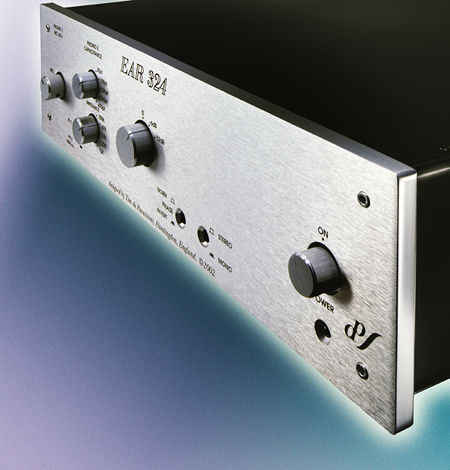
The 324 presents the serious LP enthusiast with two pairs of inputs, selectable via a pushbutton switch on the front panel. Gain for both input pairs is supplied by a trio of discrete transistors per channel, operating as a class-A amplifier. On the Phono 1 inputs, the additional gain necessary to bring the very low voltage of a traditional moving-coil (MC) cartridge up to par with that of a moving-magnet (MM) cartridge is supplied by a pair of step-up transformers, each comprising three separate primaries and one secondary in a shielded can, nicely chrome-finished. Another switch on the front panel allows the user to choose between 4, 15, and 40 ohm primaries, corresponding to additional voltage gains of 30x, 20x, and 10x, respectively. Each primary for each channel is addressed with a relay, for greater signal integrity than would be possible using a switch. (The same trannies are available in the company's standalone step-up transformer, the MC3, but that $1195 product uses separate pairs of input jacks instead of relays.) The transformers can also be switched out of the Phono 1 circuits entirely, for use with any cartridge whose output exceeds 1.0mV or so.
The pair of inputs labeled Phono 2 are optimized for an MM cartridge: These bypass the trannies altogether, but route the phono signal through a brace of capacitance and impedance choices: 20, 100, 220, 330, and 470 picofarads for the former, and 15k, 22k, 33k, 47k, and 100k ohms for the latter. As with the transformer primaries and input impedances described above for Phono 1, the Phono 2 choices are also switched from the front panel, also addressing a bank of relays.
Before moving on to the 324's other features, let's consider the technical reasons a designer would choose a combination of step-up transformers and active gain for his phono preamp, rather than using active devices alone. As you know, a phono cartridge can't drive an active gain stage unless the input of the latter presents an impedance that's significantly higher than the cartridge's own coils: Ohm's Law says that, all other things being equal, signal voltage can't go up unless its current goes down—so people generally try to have active inputs that are higher in impedance than the cartridge's own relative handful of ohms, all the way up to a whopping 47k ohms and beyond.
But when we speak of impedance instead of mere resistance, we're speaking of something that's frequency-dependent—and that's where things get sticky. The impedance differential required for a source to drive a gain stage effectively, taken by most people to be a factor between 50 and 100, is unlikely to make this stickiness an issue. But when you load a 4 ohm source with 47k ohms of shunt resistance, you will exaggerate, rather than flatten, any frequency-related response anomalies that are present in that source. And an MC cartridge has at least one of those anomalies, notwithstanding its theoretical superiority in other regards (footnote 1).
The loading game changes when we precede our active stage with a transformer, which works by inverting the ratio between voltage and current: low voltage and high current at the primary (input) become low current and high voltage at the secondary (output). With a step-up transformer, then, we don't need to create an impedance differential between source and load at all: All the voltage we need appears at the secondary, virtually without cost.
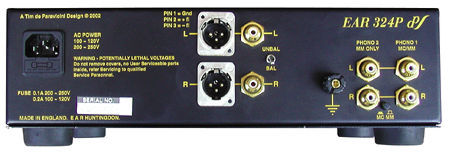
Conditions at the secondary are such that no reasonable gain stage could complain: There's enough voltage to drive any number of different devices. Back at the primary, the only requirement is that source and input impedances be at least reasonably close to one another, for the sake of electrical efficiency at most frequencies. Thus, a step-up transformer is kind to the music signal in many ways: It does not blow frequency-related response bumps out of proportion, it is electrically efficient, it does not create unwanted impedance "reflections," and it provides an operating condition in which the cartridge can control itself—which is to say, there is no electromotive force interfering with the cantilever's work.( A fanciful term for such an electromotive force might be "electrically induced mistracking" or perhaps "backward mistracking.")
And in case you detect the unmistakable scent of sympathy in the preceding paragraphs, let me confess: I do in fact think that an MC cartridge that's well-matched to a step-up transformer is capable of much more drama, and much less distortion of the sort I find objectionable, than an MC cartridge driving active devices—or even an MM cartridge driving fewer of those devices. The only time when simpler isn't better is when simpler is worse.
Back to the EAR 324's technical features: In addition to the front-panel switches and knobs for selecting phono inputs and choosing between various loading parameters, there are a few other, equally useful things. A pushbutton mono switch serves an obvious, important duty when listening to Toscanini (all) or Eddie Cochran (most) records. Another pushbutton lets you invert the absolute polarity of the signal, which can be useful...albeit only with recordings that are not egregiously multimiked, and only to the extent that its use doesn't encourage fiddling, sound worshipping, or out-and-out weirdness. And a three-position knob lets you choose between full gain (54dB) and 6 or 12dB of attenuation, the latter two being useful when you're comparing an MC's performance into different transformer primaries and you want a quick and positive way of effecting at least approximate level matching for the sake of a fair comparison.
The 324's signal output comes in unbalanced (phono jacks) and balanced (XLR sockets) flavors, the latter being true balanced in the sense that it is not derived through the use of an extra inverter—but not quite as true as can be, since there are no balanced inputs, which would of course require special tonearm wiring (footnote 2). Both unbalanced and balanced outputs are taken from the secondaries of two very hefty transformers. That's right: output transformers, just as in the Audio Note M2 preamp I reviewed last issue. Thus, the EAR 324 can be expected to drive the line inputs of any preamp or amp without difficulty. In fact, in a moment of what passes for whimsy around here, I connected the 324's balanced outputs straight to the balanced inputs of my own EAR 890 power amplifier, using the latter's input level controls to adjust listening volume. It worked. (But the sound was not, to my way of hearing, superior in any way to the system's performance with my regular preamp in place.)
In true EAR fashion, the 324's power supply is elegantly simple, being centered around a smallish toroidal transformer that's nicely shielded in its own metal sub-enclosure. Four smoothing caps complete the scene—but there is no power-supply regulation at all, Tim de P relying instead on passive filtering in both the power supply itself and within the active circuitry. (There's a pair of nicely shielded can-type inductors in the latter for this purpose, which I originally mistook for trannies.) There is also an inductor in the power supply, between the rectifier bridge and the first smoothing caps, which helps reduce electrical and mechanical noise, and which provides some measure of regulation in the bargain.
The 324 remained cool to the touch at all times, even when powered up around the clock—although it seemed to reach full potential after just half an hour. Construction quality is fine, with an especially robust chassis that's cleverly reinforced, apparently to resist the torsional forces exerted by the two heavy output transformers. My only complaint is that the brushed-alloy faceplate, while nice enough, isn't as pretty as the heavily chromed brass faceplates of other EAR products.
Well, that's not my only complaint: When I took off the bottom cover for a glimpse of the underside of the main circuit board, I found the following message etched onto the board: "The milenium has begun already"—misspelled in precisely that way. Oh, Tim, Tim, Tim...
Footnote 1: It's also important to choose a precisely correct load impedance so the MC cartridge can damp itself, electrically. I'm reluctant to put my hand in the hornets' nest by suggesting, even approximately, what the right number should be, but I'll speak from personal experience and say that I don't believe I've ever heard a cartridge perform properly into a 47k ohm load.—Art Dudley
Footnote 2: Because a phono cartridge is that rare component that naturally exists in a balanced state—its AC goes back and forth in a symmetrical circuit, without being referenced to ground—I'm anxious to try this some day. It's on my "to do" list, along with remodeling the kitchen and saving up for a horse.—Art Dudley
- Log in or register to post comments
